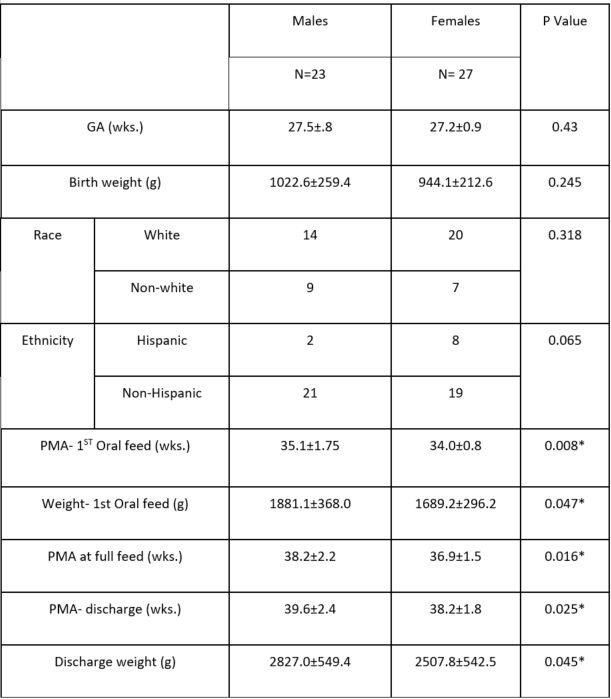Neonatal Fetal Nutrition & Metabolism
Category: Abstract Submission
Neonatal Fetal Nutrition & Metabolism II
288 - Evaluating the Effect of Infant Sex on a Standardized Cue-Based Feeding (CBF) Protocol in Preterm Infants (PTI)
Friday, April 22, 2022
6:15 PM - 8:45 PM US MT
Poster Number: 288
Publication Number: 288.120
Publication Number: 288.120
Isabelle M. Moore, University of Connecticut School of Medicine, Bloomfield, CT, United States; Madeline Walker, University of Connecticut School of Medicine, Brookfield, CT, United States; Naveed Hussain, Connecticut Children's, Farmington, CT, United States; Ted S. Rosenkrantz, University of Connecticut School of Med, Farmington, CT, United States; leonard i. eisenfeld, UCONN, West Hartford, CT, United States; Mariann Pappagallo, University of Connecticut School of Medicine, Farmington, CT, United States

Isabelle Moore, BA, BS (she/her/hers)
Medical Student
University of Connecticut School of Medicine
Brookfield, Connecticut, United States
Presenting Author(s)
Background: The achievement of sufficient oral feeds is a competency that determines the timing of PTI discharge from the NICU. CBF focuses on developmental cues and feeding quality rather than quantity. Evidence shows that infants achieve full oral feeding earlier with CBF than those fed with volume driven methods, but few studies have evaluated oral feeding outcomes using this protocol. Sex is a major predictor of NICU outcomes. Thus we have hypothesized that infant sex will affect time to full oral feeds in premature infants.
Objective: To determine the impact of sex on the achievement of full oral feeds in premature infants born at 26-29 wks. gestational age (GA), using a standardized CBF protocol.
Design/Methods: A retrospective study was conducted at Connecticut Children’s NICU at UConn Health in Farmington, CT from the time of CBF implementation in Jan 2017 to Mar 2021. Feeding data was collected through chart review. Inclusion criteria consisted of infants between 26 wks. and 29 wks. and 6 days GA at birth. This GA distribution centers around the border between extremely and moderately premature infants, 28 wks. GA. Infants transferred out of the NICU before reaching full oral feeds (140cc/k/day), transferred in after starting a non-CBF protocol, or with genetic, GI, congenital heart or neurological abnormalities as well as infants with NEC were excluded due to impact on feeding velocity. Potential confounders, including BPD, RDS, PDA, IVH, ROP, and GERD, were included in the analysis. Two-tailed unpaired Student’s t-tests, Chi-squared test and multiple linear regression (MLR) were used for data analysis.
Results: (See Table 1.) Data from 50 infants (male (M) n=27 and female (F) n=23) were included. F attained first and full oral feeds and were discharged one week earlier than M (P < .05). Despite F attaining earlier oral feeds, M weighed significantly more at their first and full oral feeds and at discharge. There were no significant sex differences in GA at birth, race, ethnicity, birth weight, length, head circumference, and z scores. A MLR confirmed the lack of effect of any of the studied confounders on the sex differences in attainment of earlier full oral feeds in F compared to M.Conclusion(s): Use of a standardized CBF protocol in the NICU demonstrated earlier achievement of feeding milestones (PMA at first and full oral feeds) in F compared to M. Weight differences of F vs M are likely due to PMA differences. F infants reached physiological criteria for discharge at earlier PMA. We plan to conduct further analysis to include infants ranging from 23 wks. to 31 wks., to further validate our findings.
Table 1. Sex Comparison of Feeding Outcomes using CBF Data shown as mean ± Standard Deviation
Data shown as mean ± Standard Deviation
Objective: To determine the impact of sex on the achievement of full oral feeds in premature infants born at 26-29 wks. gestational age (GA), using a standardized CBF protocol.
Design/Methods: A retrospective study was conducted at Connecticut Children’s NICU at UConn Health in Farmington, CT from the time of CBF implementation in Jan 2017 to Mar 2021. Feeding data was collected through chart review. Inclusion criteria consisted of infants between 26 wks. and 29 wks. and 6 days GA at birth. This GA distribution centers around the border between extremely and moderately premature infants, 28 wks. GA. Infants transferred out of the NICU before reaching full oral feeds (140cc/k/day), transferred in after starting a non-CBF protocol, or with genetic, GI, congenital heart or neurological abnormalities as well as infants with NEC were excluded due to impact on feeding velocity. Potential confounders, including BPD, RDS, PDA, IVH, ROP, and GERD, were included in the analysis. Two-tailed unpaired Student’s t-tests, Chi-squared test and multiple linear regression (MLR) were used for data analysis.
Results: (See Table 1.) Data from 50 infants (male (M) n=27 and female (F) n=23) were included. F attained first and full oral feeds and were discharged one week earlier than M (P < .05). Despite F attaining earlier oral feeds, M weighed significantly more at their first and full oral feeds and at discharge. There were no significant sex differences in GA at birth, race, ethnicity, birth weight, length, head circumference, and z scores. A MLR confirmed the lack of effect of any of the studied confounders on the sex differences in attainment of earlier full oral feeds in F compared to M.Conclusion(s): Use of a standardized CBF protocol in the NICU demonstrated earlier achievement of feeding milestones (PMA at first and full oral feeds) in F compared to M. Weight differences of F vs M are likely due to PMA differences. F infants reached physiological criteria for discharge at earlier PMA. We plan to conduct further analysis to include infants ranging from 23 wks. to 31 wks., to further validate our findings.
Table 1. Sex Comparison of Feeding Outcomes using CBF
 Data shown as mean ± Standard Deviation
Data shown as mean ± Standard Deviation